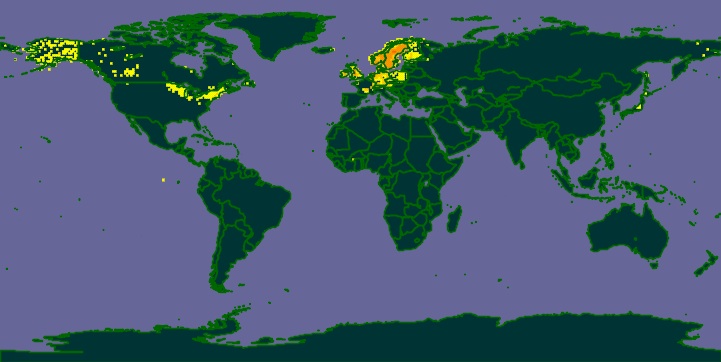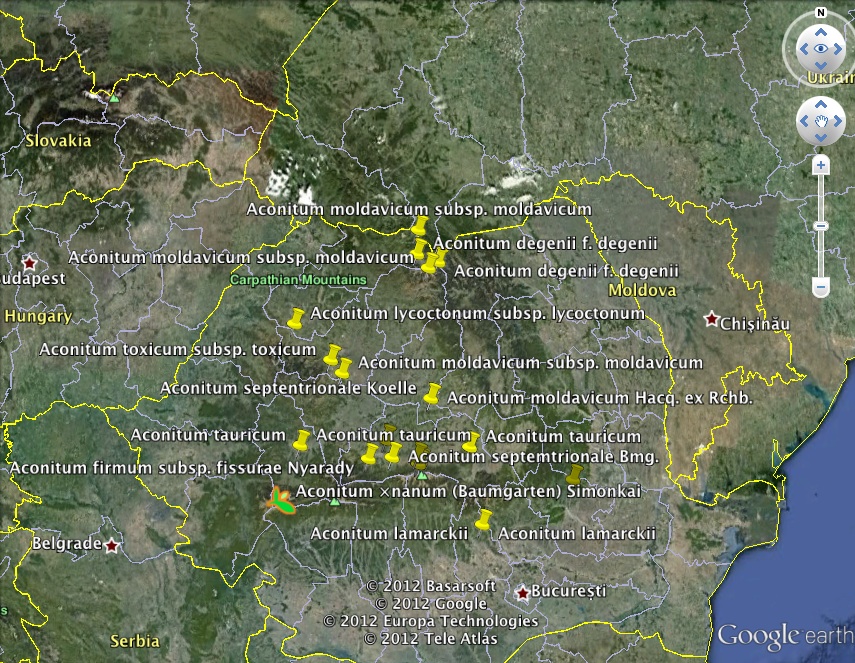
Web Resources
The classification system and scientific names used on this site are those of the Species 2000 and ITIS (Integrated Taxonomic Information System) "Catalogue of Life" cited as:
Bisby F.A., Roskov Y.R., Orrell T.M., Nicolson D., Paglinawan L.E., Bailly N., Kirk P.M., Bourgoin T., Baillargeon G., Ouvrard D., eds (2011). Species 2000 & ITIS Catalogue of Life: 2011 Annual Checklist. Digital resource at www.catalogueoflife.org/annual-checklist/2011/. Species 2000: Reading, UK.
Bisby FA, Roskov YR, Orrell TM, Nicolson D, Paglinawan LE, Bailly N, Kirk PM, Bourgoin T, Baillargeon G., eds (2010). Species 2000 & ITIS Catalogue of Life: 2010 Annual Checklist. Digital resource at http://www.catalogueoflife.org/annual-checklist/2010. Species 2000: Reading, UK.
Bisby FA, Roskov YR, Orrell TM, Nicolson D, Paglinawan LE, Bailly N, Kirk PM, Bourgoin T, Baillargeon G., eds (2009). Species 2000 & ITIS Catalogue of Life: 2009 Annual Checklist. Digital resource at www.catalogueoflife.org/annual-checklist/2009/. Species 2000: Reading, UK.
Bisby FA, Roskov YR, Orrell TM, Nicolson D, Paglinawan LE, Bailly N, Kirk PM, Bourgoin T, van Hertum J, eds (2008). Species 2000 & ITIS Catalogue of Life: 2008 Annual Checklist. Digital resource at www.catalogueoflife.org/annual-checklist/2008/. Species 2000: Reading, U.K.
FA Bisby, YR Roskov, MA Ruggiero, TM Orrell, LE Paglinawan, PW Brewer, N Bailly, J van Hertum, eds (2007). Species 2000 & ITIS Catalogue of Life: 2007 Annual Checklist. Digital resource at www.catalogueoflife.org/annual-checklist/2007/. Species 2000: Reading, U.K.
FA Bisby, MA Ruggiero, KL Wilson, M Cachuela-Palacio, SW Kimani, YR Roskov, A Soulier-Perkins and J van Hertum, eds (2005). Species 2000 & ITIS Catalogue of Life: 2005 Annual Checklist. Digital resource at www.catalogueoflife.org/annual-checklist/2005/. Species 2000: Reading, U.K.
Information on species found on this site came from the following databases:
![]()



In 2005 you could enter the name of a species and rely on finding it. Unfortunately, a single species may have many biological names, something they usually glossed over in high school when discussing the virtues of the binomial naming system. To solve this problem, a single name was chosen for each species and all other names were regarded as synonyms. In the Catalogue of Life, until 2009, entering a synonym would lead to the accepted name. However, later versions of the catalogue do not seem to recognize synonyms when using the search function. Furthermore I have had trouble loading the later versions and often experience problems with the searches.
I recommend using the 2005 Catalogue. For members of Fabaceae use the google method below. If the Catalogue leads to the ITIS database look near the bottom of the page for the link to the database maintained by ITIS-Canada
http://www.cbif.gc.ca/...
This will lead to the latest information on the species.
The KEW database has been undergoiing an upgrade and after 2005 has returned numerous accepted names for a species. This database has undergone tremendous improvement since 2009 and now returns the accepted name, but doesn't respond to the synonyms.
For information on species in the U.S., Canada and Mexico it is best to use the ITIS database maintained by ITIS-US and really the best way to access it is through Google. Simply enter the species name and taxonomic serial (ie aster sibiricus taxonomic serial) and Google should find
Aster sibiricus - Integrated Taxonomic
Information System
www.itis.gov/servlet/SingleRpt/SingleRpt?search_topic=TSN...
6 days ago – Taxonomic Serial No.: 193008. Taxonomy and Nomenclature
... This
record was originally "Aster sibiricus sibiricus" (TSN 193008),
and was ...
Click and you will find that the correct name is Eurybia sibirica and if you click on the blue link you will arrive at the page for
Eurybia sibirica (L.) G.L. Nesom
Taxonomic Serial No.: 513459.
Species Location Information
Biota of North America Program (BONAP)
BONAP's home site gives access to maps which
show the presence of absence of various species by state or province.
For some states, data by county is available.
BONAP also has a Flickr site with photos of a huge number of species.
http://www.flickr.com/photos/bonap/
I recommend using google to navigate to the maps and photos. For example for the species Cerastium arvense: For maps, simply Google: bonap maps cereastium. The first two results will lead to the maps for the genus Cereastium. www.bonap.org/BONAPNAmaps2011/Cerastium.html lacks the county maps. For the flicker site, Google:bonap flickr cerastium arvense to see the photos of the species or bonap flickr cereastium to get to the beginning of the section on the genus Cereastium
Kartesz, J.T., The Biota of North America Program (BONAP). 2011. North American Plant Atlas (http://www.bonap.org/MapSwitchboard.html). Chapel Hill, N.C. [maps generated from Kartesz, J.T. 2010. Floristic Synthesis of North America, Version 1.0. Biota of North America Program (BONAP). (in press)].
************
Global Biodiversity Information Facility (GBIF)
http://www.gbif.org/
This site gives access to information on samples of species collected throughout the world. You will need to agree to some restrictions on the use of the data. Enter the name of the organism (genus species). This gives access to a map of the worldwide distribution of the species and the ability to download a kml file to be used on Google Earth which will show the locations where specimens have been collected. There is a limit to the amount of information which the kml file can provide and often for Alaskan specimens and even U.S. specimens the file is inadequate since preference is often given to specimens collected in Europe. For example: andromeda polifolia yields this occurrance overview map.

based on over 41,000 records with coordinates. This map is from http://data.gbif.org/species/5333413/. Click on "Countries with Occurances". 32546 specimens were collected in Sweden and 6734 were collected in Norway. By checking the box next to "United States" and clicking on "Refine search" you will advance to a page which will lead to the kml file for the 717 specimens colleced in the US. Under Download: click on "Google Earth (maximum 50,000)". This brings you to a new page. Click on "occurrence-search-xxx...xxx.zip (approx file size 18 KB)" to download the kml file. This file will be in an "occurrance search" folder. Double click the file to activate the Google Earth program. If you don't have the program, use Google to find and download it. Google Earth gives you access to the individual records by clicking on the symbol on the map for that record. Below is a screenshot from Google Earth for Aconitum (monkshood) in Romania.
